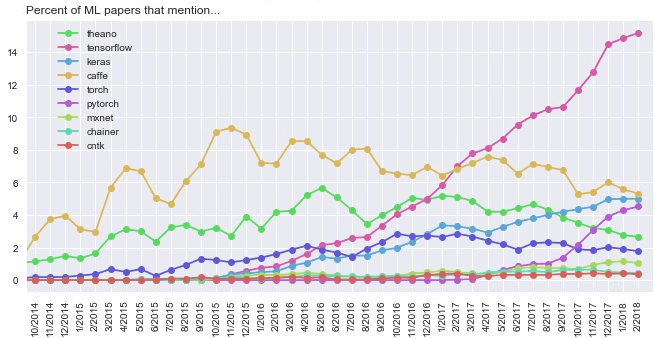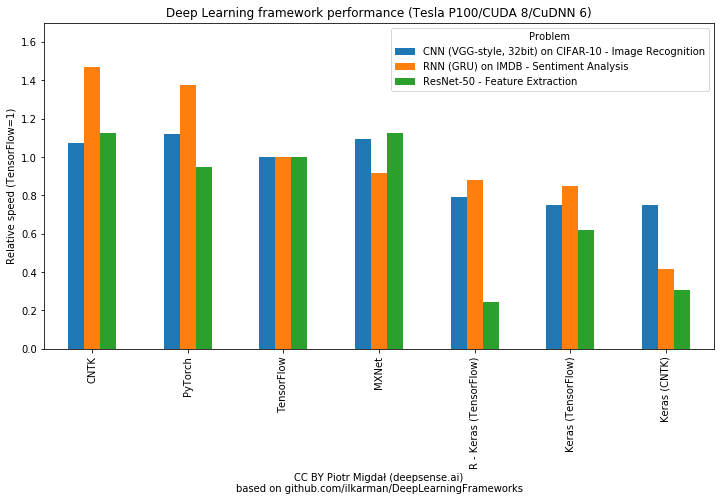Article Source
- Title: Keras vs. PyTorch
Keras or PyTorch as your first deep learning framework
So, you want to learn deep learning? Whether you want to start applying it to your business, base your next side project on it, or simply gain marketable skills – picking the right deep learning framework to learn is the essential first step towards reaching your goal.
We strongly recommend that you pick either Keras or PyTorch. These are powerful tools that are enjoyable to learn and experiment with. We know them both from the teacher’s and the student’s perspective. Piotr has delivered corporate workshops on both, while Rafał is currently learning them.
(See the discussion on Hacker News and Reddit).
Introduction
Keras and PyTorch are open-source frameworks for deep learning gaining much popularity among data scientists.
- Keras is a high-level API capable of running on top of TensorFlow, CNTK, Theano, or MXNet (or as tf.contrib within TensorFlow). Since its initial release in March 2015, it has gained favor for its ease of use and syntactic simplicity, facilitating fast development. It’s supported by Google.
- PyTorch, released in October 2016, is a lower-level API focused on direct work with array expressions. It has gained immense interest in the last year, becoming a preferred solution for academic research, and applications of deep learning requiring optimizing custom expressions. It’s supported by Facebook.
Before we discuss the nitty-gritty details of both frameworks (well described in this Reddit thread), we want to preemptively disappoint you – there’s no straight answer to the ‘which one is better?’. The choice ultimately comes down to your technical background, needs, and expectations. This article aims to give you a better idea of where each of the two frameworks you should be pick as the first.
Keras may be easier to get into and experiment with standard layers, in a plug & play spirit.
PyTorch offers a lower-level approach and more flexibility for the more mathematically-inclined users.
Ok, but why not any other framework?
This article will not discuss the merits and drawbacks of picking pure TensorFlow as your first deep learning framework, as we think it’s less beginner-friendly compared to Keras (the official high-level library of TF) and PyTorch. While you may find some Theano tutorials, it is no longer in active development. Caffe lacks flexibility, while Torch uses Lua (though its rewrite is awesome :)). MXNet, Chainer, and CNTK are currently not widely popular.
Keras vs. PyTorch: Ease of use and flexibility
Keras and PyTorch differ in terms of the level of abstraction they operate on.
Keras is a higher-level framework wrapping commonly used deep learning layers and operations into neat, lego-sized building blocks, abstracting the deep learning complexities away from the precious eyes of a data scientist.
PyTorch offers a comparatively lower-level environment for experimentation, giving the user more freedom to write custom layers and look under the hood of numerical optimization tasks. Development of more complex architectures is more straightforward when you can use the full power of Python and access the guts of all functions used. This, naturally, comes at the price of verbosity.
Consider this head-to-head comparison of how a simple convolutional network is defined in Keras and PyTorch:
Keras
model = Sequential()
model.add(Conv2D(32, (3, 3), activation='relu', input_shape=(32, 32, 3)))
model.add(MaxPool2D())
model.add(Conv2D(16, (3, 3), activation='relu'))
model.add(MaxPool2D())
model.add(Flatten())
model.add(Dense(10, activation='softmax'))
PyTorch
class Net(nn.Module):
def __init__(self):
super(Net, self).__init__()
self.conv1 = nn.Conv2d(3, 32, 3)
self.conv2 = nn.Conv2d(32, 16, 3)
self.fc1 = nn.Linear(16 * 6 * 6, 10)
self.pool = nn.MaxPool2d(2, 2)
def forward(self, x):
x = self.pool(F.relu(self.conv1(x)))
x = self.pool(F.relu(self.conv2(x)))
x = x.view(-1, 16 * 6 * 6)
x = F.log_softmax(self.fc1(x), dim=-1)
return x
model = Net()
The code snippets above give a little taste of the differences between the two frameworks. As for the model training itself – it requires around 20 lines of code in PyTorch, compared to a single line in Keras. Enabling GPU acceleration is handled implicitly in Keras, while PyTorch requires us to specify when to transfer data between the CPU and GPU.
If you’re a beginner, the high-levelness of Keras may seem like a clear advantage. Keras is indeed more readable and concise, allowing you to build your first end-to-end deep learning models faster, while skipping the implementational details. Glossing over these details, however, limits the opportunities for exploration of the inner workings of each computational block in your deep learning pipeline. Working with PyTorch may offer you more food for thought regarding the core deep learning concepts, like backpropagation, and the rest of the training process.
That said, Keras, being much simpler than PyTorch, is by no means a toy – it’s a serious deep learning tool used by beginners, and seasoned data scientists alike. For instance, in the Dstl Satellite Imagery Feature Detection Kaggle competition, the 3 best teams used Keras in their solutions, while our deepsense.ai team (4th place) used a combination of PyTorch and (to a lesser extend) Keras.
Whether your applications of deep learning will require flexibility beyond what pure Keras has to offer is worth considering. Depending on your needs, Keras might just be that sweet spot following the rule of least power.
SUMMARY
- Keras – more concise, simpler API
- PyTorch – more flexible, encouraging deeper understanding of deep learning concepts
Keras vs. PyTorch: Popularity and access to learning resources
A framework’s popularity is not only a proxy of its usability. It is
also important for community support – tutorials, repositories with
working code, and discussions groups. As of June 2018, Keras and PyTorch
are both enjoying growing popularity, both on GitHub and arXiv papers
(note that most papers mentioning Keras mention also its TensorFlow
backend). According to a KDnuggets survey, Keras and PyTorch are the
fastest growing data science
tools.

Unique mentions of deep learning frameworks in arxiv papers (full text) over time, based on 43K ML papers over last 6 years. So far TF mentioned in 14.3% of all papers, PyTorch 4.7%, Keras 4.0%, Caffe 3.8%, Theano 2.3%, Torch 1.5%, mxnet/chainer/cntk <1%. (cc @fchollet) pic.twitter.com/YOYAvc33iN
— Andrej Karpathy (@karpathy) 10 marca 2018
While both frameworks have satisfactory documentation, PyTorch enjoys stronger community support – their discussion board is a great place to visit to if you get stuck (you will get stuck) and the documentation or StackOverflow don’t provide you with the answers you need.
Anecdotally, we found well-annotated beginner level deep learning courses on a given network architecture easier to come across for Keras than for PyTorch, making the former somewhat more accessible for beginners. The readability of code and the unparalleled ease of experimentation Keras offers may make it the more widely covered by deep learning enthusiasts, tutors and hardcore Kaggle winners.
For examples of great Keras resources and deep learning courses, see “Starting deep learning hands-on: image classification on CIFAR-10“ by Piotr Migdał and “Deep Learning with Python” – a book written by François Chollet, the creator of Keras himself. For PyTorch resources, we recommend the official tutorials, which offer a slightly more challenging, comprehensive approach to learning the inner-workings of neural networks. For a concise overview of PyTorch API, see this article.
SUMMARY
- Keras – Great access to tutorials and reusable code
- PyTorch – Excellent community support and active development
Keras vs. PyTorch: Debugging and introspection
Keras, which wraps a lot of computational chunks in abstractions, makes it harder to pin down the exact line that causes you trouble. PyTorch, being the more verbose framework, allows us to follow the execution of our script, line by line. It’s like debugging NumPy – we have easy access to all objects in our code and are able to use print statements (or any standard Pythonic debugging) to see where our recipe failed. A Keras user creating a standard network has an order of magnitude fewer opportunities to go wrong than does a PyTorch user. But once something goes wrong, it hurts a lot and often it’s difficult to locate the actual line of code that breaks. PyTorch offers a more direct, unconvoluted debugging experience regardless of model complexity. Moreover, when in doubt, you can readily lookup PyTorch repo to see its readable code.
SUMMARY
- PyTorch – way better debugging capabilities
- Keras – (potentially) less frequent need to debug simple networks
Keras vs. PyTorch: Exporting models and cross-platform portability
What are the options for exporting and deploying your trained models in production?
PyTorch saves models in Pickles, which are Python-based and not portable, whereas Keras takes advantages of a safer approach with JSON + H5 files (though saving with custom layers in Keras is generally more difficult). There is also Keras in R, in case you need to collaborate with a data analyst team using R.
Running on Tensorflow, Keras enjoys a wider selection of solid options for deployment to mobile platforms through TensorFlow for Mobile and TensorFlow Lite. Your cool web apps can be deployed with TensorFlow.js or keras.js. As an example, see this deep learning-powered browser plugin detecting trypophobia triggers, developed by Piotr and his students.
Exporting PyTorch models is more taxing due to its Python code, and currently the widely recommended approach is to start by translating your PyTorch model to Caffe2 using ONNX.
SUMMARY
- Keras – more deployment options (directly and through the TensorFlow backend), easier model export.
Keras vs. PyTorch: Performance
Donald Knuth famously said:
Premature optimization is the root of all evil (or at least most of it) in programming.
In most instances, differences in speed benchmarks should not be the main criterion for choosing a framework, especially when it is being learned. GPU time is much cheaper than a data scientist’s time. Moreover, while learning, performance bottlenecks will be caused by failed experiments, unoptimized networks, and data loading; not by the raw framework speed. Yet, for completeness, we feel compelled to touch on this subject. We recommend these two comparisons:
- TensorFlow, Keras and PyTorch comparison by Wojtek Rosiński
- Comparing Deep Learning Frameworks: A Rosetta Stone Approach by Microsoft (make sure to check notebooks to get the taste of different frameworks). For a detailed explanation of the multi-GPU framework comparisons, see this article.
PyTorch is as fast as TensorFlow, and potentially faster for Recurrent Neural Networks. Keras is consistently slower. As the author of the first comparison points out, gains in computational efficiency of higher-performing frameworks (ie. PyTorch & TensorFlow) will in most cases be outweighed by the fast development environment, and the ease of experimentation Keras offers.


SUMMARY:
- As far as training speed is concerned, PyTorch outperforms Keras
Keras vs. PyTorch: Conclusion
Keras and PyTorch are both excellent choices for your first deep learning framework to learn. If you’re a mathematician, researcher, or otherwise inclined to understand what your model is really doing, consider choosing PyTorch. It really shines, where more advanced customization (and debugging thereof) is required (e.g. object detection with YOLOv3 or LSTMs with attention) or when we need to optimize array expressions other than neural networks (e.g. matrix decompositions or word2vec algorithms).
Keras is without a doubt the easier option if you want a plug & play framework: to quickly build, train, and evaluate a model, without spending much time on mathematical implementation details.
Knowledge of the core concepts of deep learning is transferable. Once you master the basics in one environment, you can apply them elsewhere and hit the ground running as you transition to new deep learning libraries.
We encourage you to try out simple deep learning recipes in both Keras and PyTorch. What are your favourite and least favourite aspects of each? Which framework experience appeals to you more? Let us know in the comment section below!
Would you and your team like to learn more about deep learning in Keras, TensorFlow and PyTorch? See our tailored training offers.